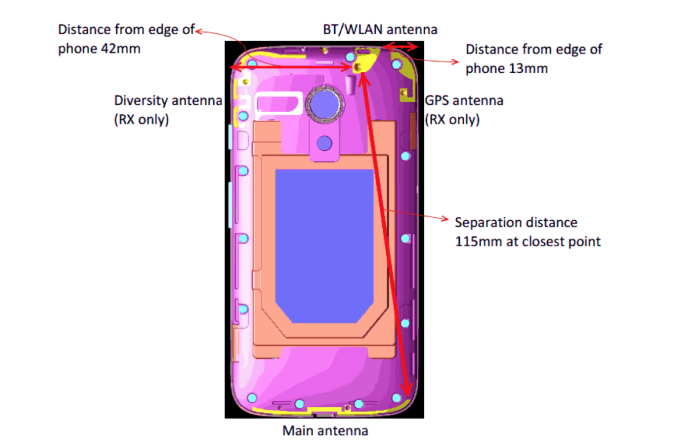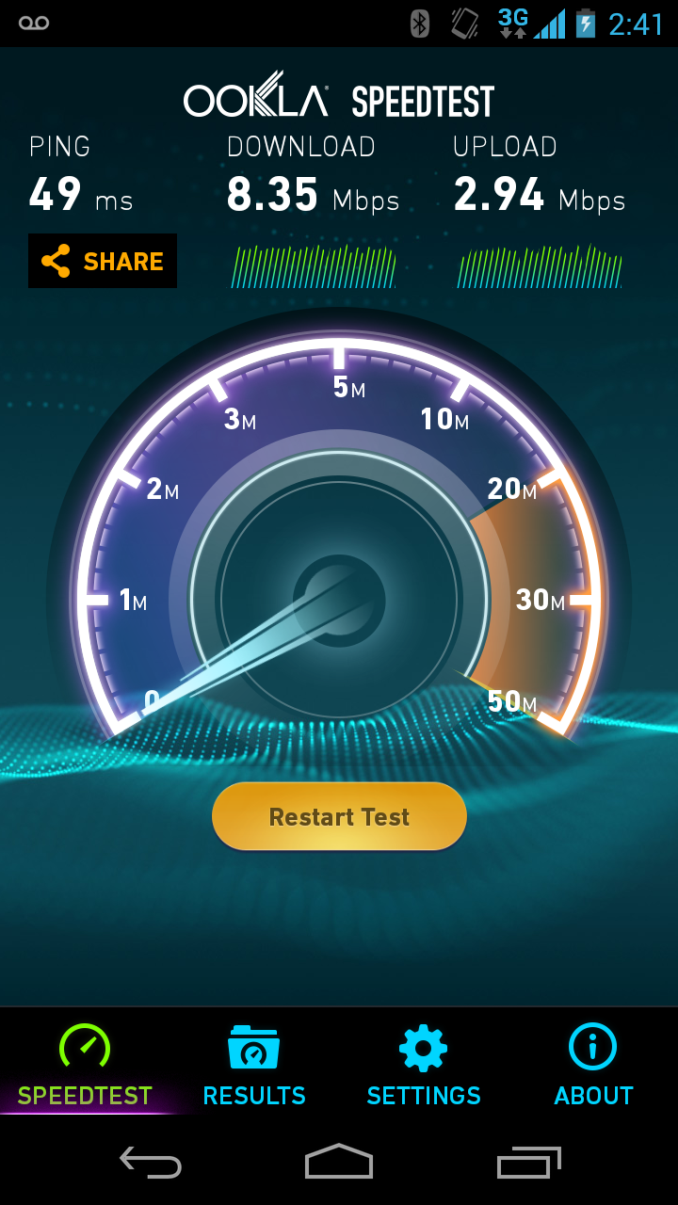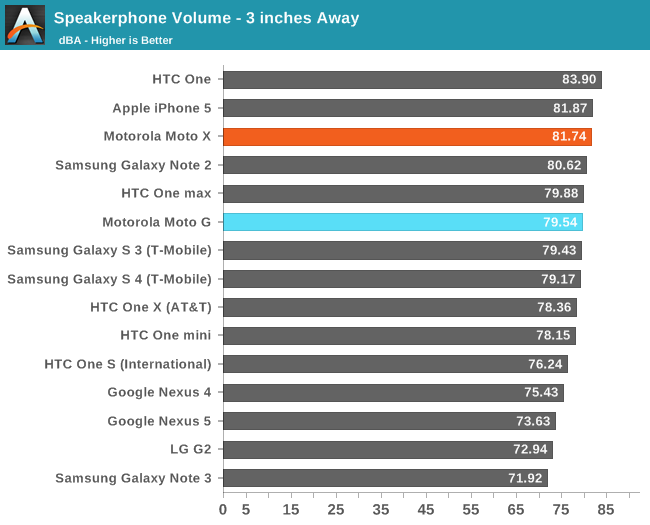Motorola Moto G Review
by Brian Klug on December 18, 2013 2:00 PM EST- Posted in
- Smartphones
- Motorola
- Mobile
- *VA
- Cortex A7
- snapdragon 400
- Moto G
Cellular
The cellular side of the Moto G is an interesting one, at least for those who have kept constantly abreast of wireless banding configurations and the state of mobile RF. At the high end, pentaband WCDMA is now essentially ubiquitous, with parity LTE banding (given the shared nature of ports on the transceiver) and at least a handful more bands for whatever’s appropriate to the region. There’s no global LTE band combination equivalent to quad band GSM or pentaband WCDMA that has emerged quite yet, but it’s getting there, and in the next generation or two we’ll undoubtedly finally see it come to fruition.
|
Moto G (US GSM) |
Moto G (Global GSM) |
Moto G (CDMA) |
|
| Baseband | MSM8x26 - (Up to HSDPA 21.1 Enabled, EVDO Rev.A for CDMA) | ||
| Transceiver | WTR2605/WFR2600 (?) | ||
| GSM | 850/900/1800/1900 MHz | - | |
| CDMA2000 | BC: 0/1/10 | - | 850, 1900 MHz |
| WCDMA |
850, 1700/2100 (AWS), 1900 MHz (Bands 2, 4, 5) |
850, 900, 1900, 2100 MHz (Bands 1,2,5,8) |
- |
| LTE | - | - | - |
The Moto G however comes in a number of different flavors with different band combinations – there’s US GSM, Global GSM, and CDMA. I also suspect there’s at least one more dual SIM variant that we haven’t seen crop up just yet (Update: Apparently this exists already, XT1033 is the dual SIM variant, thanks @evefavretto). On the back case of Moto G there’s a space whose shape matches the microSIM tray at top, and on the board there’s a shield covering pads that are undoubtedly for a microSIM. Interestingly enough Motorola sampled me the Global GSM variant of the Moto G which lacks Band 4. I’ve been using it on T-Mobile successfully however thanks to the relative ubiquity of the 1900 MHz WCDMA carrier in my market. The US GSM variant of the Moto G trades Band 4 for 1 and 8 (2100 and 900 MHz), two popular bands internationally. I’ve seen Moto G erroneously listed as being a pentaband WCDMA phone, which it unfortunately isn’t.

Primary Rx/Tx at bottom, Diversity Rx up top, WLAN/BT, GNSS Rx
Moto G does offer a leg up with receive diversity for CDMA1x/EVDO and HSPA+, something that some HSPA+ flagships from this generation amazingly enough still don’t include. The transceiver is WTR2605 for the primary Rx and Tx ports, and WFR2600 for the additional Rx diversity path. I have no idea what the port configurations look like for WTR2605, but I’d imagine it looks like a cut down WTR1605 of some kind. I have a suspicion that WTR2605 was designed for a quad band UMTS configuration with Bands 1,2,5, and 8, so it might indeed already be port limited in the Global GSM Moto G variant. I also wouldn’t be surprised if there’s some ready made front end module at the front of the whole thing.
Moto G arrives without LTE and instead offers up to single carrier HSPA+ with 64QAM, for up to 21 Mbps on the downlink. Although MSM8x26 itself has a modem block capable of up to dual carrier HSPA+ and category 4 LTE, it seems as though Motorola went for single carrier HSPA+ in the Moto G for time to market reasons, with the LTE and dual-carrier HSPA+ enabled software tree likely slotting in a quarter later than the initial code drop with single carrier HSPA+.


Not bad for single carrier HSPA+ on T-Mobile USA
I’ve been pretty pleased with the cellular performance of the Moto G, even using the variant that lacks Band 4 on T-Mobile USA. Not having LTE made me initially skeptical of it getting operator traction in the US, but it seems as though Motorola has actually had success at least on some prepaid tiers. I’ve been spoiled with LTE devices for a long time now, but single carrier HSPA+ is absolutely still survivable.
WLAN
WiFi connectivity on Moto G is single band 2.4 GHz 802.11n with BT 4.0 and FM receive. On the Moto G, that connectivity is courtesy the new WCN3620 BT/FM/WLAN RF combo chip in a wafer scale package. We’ve now seen WCN3660, the initial dual band combo, then WCN3680 which added 802.11ac, and now WCN3620, the cost reduced version which is single band 802.11n and no doubt offered at a competitive price point with the rest of the platform.
The WLAN/BT stack doesn’t do any antenna sharing and instead has its own transmit and receive path on the top of the Moto G. I don’t have any complaints about WLAN range on the Moto G.
To evaluate performance we turn to the same iPerf test same as always. I was able to attach the Moto G to my network at the 65 Mbps PHY rate that corresponds to long guard interval with a 20 MHz channel.

Performance is pretty decent at just over 50 Mbps. It’s a significant delta over the latest devices with dual band 80 MHz 802.11ac support, but again, totally solid relative to the tier it’s in.
Speakerphone and Noise Canceling
Speakerphone on the Moto G seems to be a big chamber if you take the back off, but there’s a relatively small seal against the whole affair, although the grille has larger holes than Moto X’s relatively tiny ones. Loudness is competitive, but unsurprisingly short of Moto X.

I’d describe Moto G’s speaker as decent, not overly loud or rich sounding.
Dual microphone noise suppression is still a somewhat notable feature at the midrange. In the case of Moto G, Qualcomm’s Fluence package is used in a configuration with the primary microphone at bottom and secondary at very top. I did some digging and also found that Moto G is using Qualcomm’s WCD9302 audio codec which we haven’t seen before, again a more midrange variant. I’ll leave the earphone/line out audio testing for Chris to evaluate.
Noise suppression on the Moto G is decent, but seems to have longer adaptation time than the Moto X. Using the exact same setup, I definitely noticed better rejection on Moto X as well, with less noise being passed through at the same volume level. I should also note that the Moto G does not appear to be AMR-WB enabled on T-Mobile.
GNSS
GNSS onboard the Moto G is the same Gen 8B as we’ve seen on 8974, which translates to support for GPS (USA “Navstar”), GLONASS (Russia), and Beidou (China), although the spec table for Moto G only lists GPS and GLONASS, leading me to believe Beidou might be reserved for devices destined for China. There’s a discrete antenna for GNSS on the Moto G, and I had no issues with getting fast, accurate 3D fixes. I remain impressed with Qualcomm’s GNSS which obviously benefits from integration right into the SoC.










120 Comments
View All Comments
darwinosx - Wednesday, December 18, 2013 - link
Motorola is a Google company now no matter how they try to pretend otherwise with the whole firewall between them nonsense. I'd see how they do now. Meanwhile Google payed an idiotic sum for Motorola to get a bunch of worthless patents and is left trying to save face by still producing phones.sprockkets - Wednesday, December 18, 2013 - link
O hai appletard! Nice to see you still have a brain, somewhere.Bob Todd - Thursday, December 19, 2013 - link
Just as a small update, 4.4.2 started rolling out for the Moto G today...InvaderC1 - Saturday, December 21, 2013 - link
Moto G already had 4.4.2 shipped, and Moto X was first non-nexus device with Kit Kat. Since being bought by Google, they have turned thing around, at least with this first wave.Hakuron - Saturday, December 21, 2013 - link
Well moto g already got 4.4.2 a couple days ago. http://www.xda-developers.com/android/android-4-4-...And it has been said by motorola that the RAZR HD will as well get 4.4 soon.
Besides, taking into count that motorola has already got 5 devices running on 4.4 (Moto x, moto g, Droid ultra, maxx and mini) while other manufacturers haven't got 4.4 not even in their flagship talks really, REALLY well of their new update policy.
P.s: Old Razr (xt910) released on 2011, worst time ever for motorola, still went from 2.3 to 4.0 and from there to 4.1. Just for you to keep it in mind :)
p.s.s: Yeah, i do know that the atrix family as well as milestone didn't have the same luck, but luckily for us, they seem to have changed, for good.
Hakuron - Saturday, December 21, 2013 - link
Well moto g already got 4.4.2 a couple days ago. http://www.xda-developers.com/android/android-4-4-...And it has been said by motorola that the RAZR HD will as well get 4.4 soon.
Besides, taking into count that motorola has already got 5 devices running on 4.4 (Moto x, moto g, Droid ultra, maxx and mini) while other manufacturers haven't got 4.4 not even in their flagship talks really, REALLY well of their new update policy.
P.s: Old Razr (xt910) released on 2011, worst time ever for motorola, still went from 2.3 to 4.0 and from there to 4.1. Just for you to keep it in mind :)
p.s.s: Yeah, i do know that the atrix family as well as milestone didn't have the same luck, but luckily for us, they seem to have changed, for good.
Gunbuster - Wednesday, December 18, 2013 - link
Thumbs up for not using the prefab line from what I must assume is a google/moto payoff presskit "Moto G, simply the best phone under $200"Thumbs down for no comparison with the Lumia 520/521 that have been dipping down into the $50 range off contract.
uhuznaa - Wednesday, December 18, 2013 - link
Damned good phone considering the price point. No, even compared to quite a few more expensive ones. Absolutely impressive battery life, a camera that doesn't suck and at least as fast as the last generation of top-end phones, all in a nice package and for very little money. Well done, Motorola.CatfishTX - Wednesday, December 18, 2013 - link
A lot of phone for the money. I bought a 16GB model and will be giving it to my daughter for Christmas. She wanted good battery life, good display, and stock Android if possible. I would say the Moto G delivers all three.apertotes - Wednesday, December 18, 2013 - link
"The Moto G’s goal is pretty simple – to deliver an affordable smartphone experience that doesn’t make any sacrifices"I'd say that a maximum of 16gb of memory is a pretty big compromise. Because of those, about 12 will be available to the user, and out of those 12, at least 1 or 2 will be gone in stupid gallery thumbnails hidden files. Add 3-4 gb of music, and 2 or 3 heavy games, and you are left with less than 2 gb of free space. If you want to record videos, capture photos, or download movies, you are really screwed. And this is not a poweruser scenario at all.